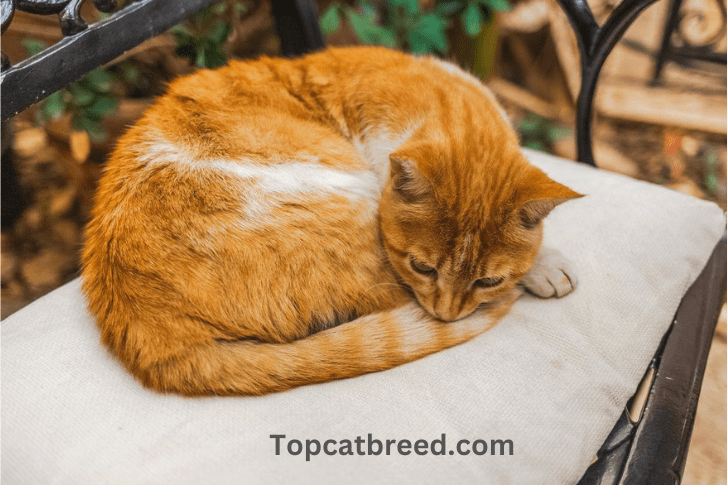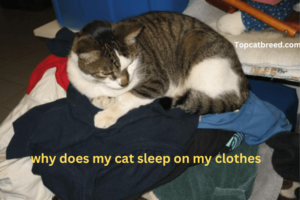Have you ever wondered, “Why do cats chase their tails?” It’s a quirky behavior that many cats display, and there’s more to it than meets the eye. Cats might chase their tails for a variety of reasons. Sometimes, it’s just playful behavior – a bit like a kitty game of tag or hide-and-seek. Fleas can also be a culprit, as they may make your cat itchy at the tail base. Hereditary Traits play a role too; some cat breeds are just more tail-chase than others!
Allergies and the need to relieve pain could be additional factors. If your cat is in discomfort or dealing with an injury, tail-chasing might be their way of signaling a problem. In this exploration, we’ll uncover nine reasons behind this adorable yet puzzling cat habit, offering simple insights for you to understand your furry friend’s behavior better. Join us as we unravel the secrets of why do cats chase their tails – a delightful journey into the whimsical world of our feline companions.
9 Reasons Why do cats chase their tails
1-Playful Behavior
One of the crucial reasons why do cats chase their tails lies in their playful behavior. Cats, being natural hunters, engage in tail-chasing during playtime, mimicking their hunting instincts. It is not only entertaining but serves as a valuable practice for their hunting skills, especially in kittens.
This playful pursuit allows them to pounce, stalk, and stay agile, showcasing their feline prowess. If your cat indulges in tail-chasing during these playful moments, it’s a delightful and harmless expression of their energetic and curious nature.
Symptoms of Playful Tail-Chasing:
- Energetic and animated behavior during playtime.
- Tail-chasing is sporadic and not accompanied by aggressive tendencies.
- Playful meowing or purring while engaging in tail-chasing.
2-To Relieve Boredom or Stress
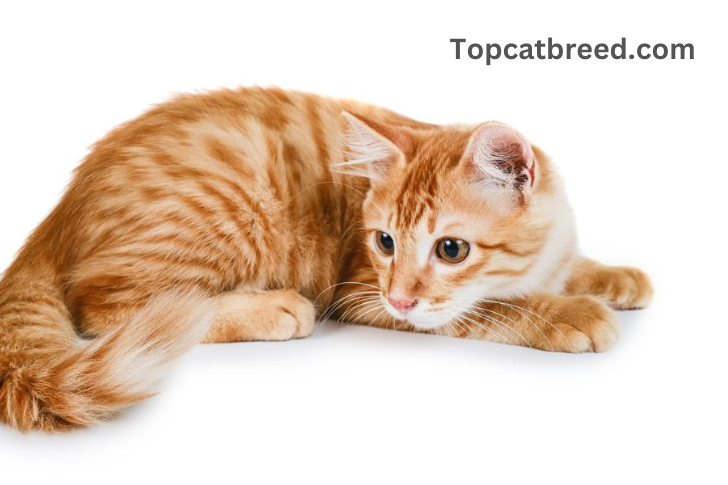
One of the important reasons why cats chase their tails is to relieve boredom or stress. Cats, much like humans, can experience moments of monotony or stress, and tail-chasing may serve as a coping mechanism.
If your cat suddenly intensifies its tail-chasing behavior, it might be signaling a need for additional mental and physical stimulation. To address this, consider introducing new toys, engaging in interactive play sessions, or creating an enriching environment with climbing structures to alleviate boredom and reduce stress.
Symptoms of Boredom- or Stress-Related Tail-Chasing:
- Increased tail-chasing frequency in response to environmental changes.
- Restlessness or signs of anxiety when left alone.
- Improved behavior with the introduction of new toys or interactive activities.
3-Your Cat Has Fleas
One of the famous reasons why cats chase their tails is the presence of fleas. Flea infestations, particularly around the base of the tail, can induce intense itchiness, leading to tail-chasing behavior. Symptoms of fleas in your cat may include excessive scratching, skin irritation, and the presence of small black specks (flea dirt) in the fur.
Promptly addressing a flea issue is crucial for your cat’s comfort and well-being. Aside from itching, fleas will cause other symptoms. If you notice any of the following indicators in your cat, you should take him to the vet.
- Bumps on the skin
- Excessive grooming
- Excessive scratching
- Spots of hair loss
- Skin irritation
- Lethargy
4-Hereditary Traits
One of the important reasons why cats chase their tails is linked to hereditary traits. Certain cat breeds, such as Siamese cats, are known for their playful nature, making them more prone to tail-chasing. While breed-specific behaviors can contribute to this tendency, individual cats within any breed may display tail-chasing behavior. Understanding your cat’s breed characteristics provides valuable insights into their playful tendencies.
Symptoms of Hereditary Tail-Chasing:
- Consistent playfulness and agility, characteristic of the breed.
- Tail-chasing behavior that aligns with the cat’s natural instincts.
- Absence of aggressive or distressed behavior during tail-chasing.
5-Allergies
One of the crucial reasons why cats chase their tails is the presence of allergies. Environmental or food-related allergies can trigger tail-chasing as cats attempt to relieve itching or discomfort. Symptoms of allergies in cats may include skin rashes, excessive grooming, vomiting, diarrhea, and respiratory issues like sneezing or wheezing. Identifying and addressing the specific allergen is crucial for managing allergies and ensuring your cat’s well-being. Allergies, like fleas, typically manifest in multiple ways. Other allergy-related symptoms that your cat may have include:
- Rashes in other areas
- Itchiness in other areas
- Vomiting
- Diarrhea
- Swollen paws
- Snoring
- Sneezing
- Wheezing
6-To Relieve Pain
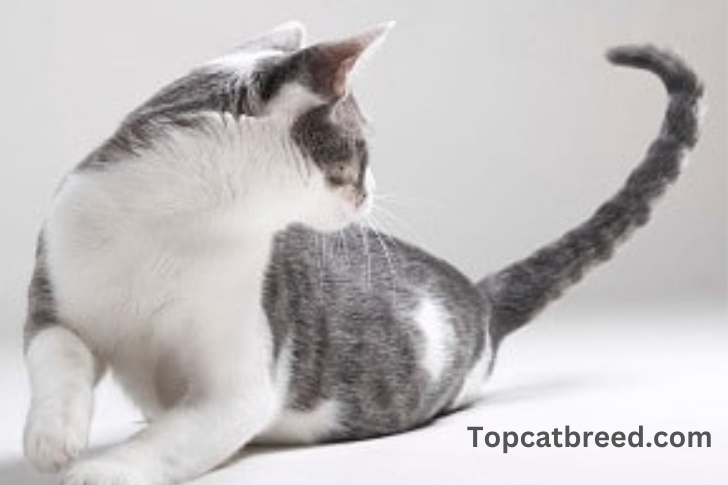
One of the crucial reasons why cats chase their tails is their innate instinct to alleviate pain or discomfort. When a cat experiences physical distress, it may resort to tail-chasing as a way to distract itself from the source of discomfort. This behavior can be indicative of various issues, including injuries, infections, or underlying health concerns.
If you observe your cat intensifying its tail-chasing and displaying signs of distress, it’s vital to seek veterinary attention. Identifying the root cause of the pain is essential to provide appropriate treatment and ensure your cat’s well-being.
ALSO READ. Why does my cat twitch in her sleep? 9 reasons
7-Injury or Pain
An important factor contributing to tail-chasing is injury or pain. Cats may engage in this behavior as a response to physical injuries, wounds, or pain in the tail region. It serves as a way for them to draw attention to the affected area.
If you notice your cat excessively grooming, biting, or showing signs of discomfort around its tail, a thorough examination by a veterinarian is crucial. Prompt intervention can prevent complications and facilitate the healing process.
8-Stud Tail
A significant aspect related to tail issues is the occurrence of stud tail. This condition, similar to human acne, is more commonly observed in young and unneutered male cats undergoing puberty. Stud tail is characterized by blackheads, greasy fur, pus, and red bumps near the tail.
Veterinary intervention is necessary to address stud tail effectively. Treatment may involve thorough cleaning, topical medications, and, in some cases, neutering to manage hormonal imbalances contributing to the condition. Cats with stud tails may have blackheads between their tail hairs. The hair in the area can also become oily, and the skin can become rough and irritated. Other indications to look out for include:
- Pus at or near the tail.
- Red bumps at the tail
- Yellowing tail fur.
- Loss of hair around the tail
9-Feline Hyperesthesia Syndrome
One of the crucial syndromes associated with tail-chasing behavior is Feline Hyperesthesia Syndrome (FHS). This neurological condition results in heightened skin sensitivity, primarily affecting the back and tail region.
Cats with FHS may exhibit behaviors like tail-chasing, twitching, and heightened reactivity to touch. While the exact cause of FHS is not fully understood, some veterinarians associate it with obsessive-compulsive or seizure disorders. Siamese cats, in particular, seem genetically predisposed to FHS.
Treatment of Feline Hyperesthesia Syndrome:
- Veterinary Consultation: Seek professional advice to confirm the diagnosis and discuss an appropriate treatment plan.
- Medications: Anti-anxiety medications or anticonvulsants may be prescribed to manage symptoms.
- Environmental Enrichment: Provide a stimulating environment to reduce stress and boredom, including interactive toys and climbing structures.
- Dietary Changes: Some cases may benefit from dietary modifications, including hypoallergenic or specialized diets.
- Regular Monitoring: Keep a close eye on your cat’s behavior and consult with the vet for adjustments in the treatment plan if needed.
Understanding these less common reasons for tail-chasing underscores the importance of attentive care and timely veterinary intervention. By addressing the underlying causes, cat owners can contribute to their feline companions’ overall health and well-being.
What Does It Mean When a Cat Chases Its Tail?
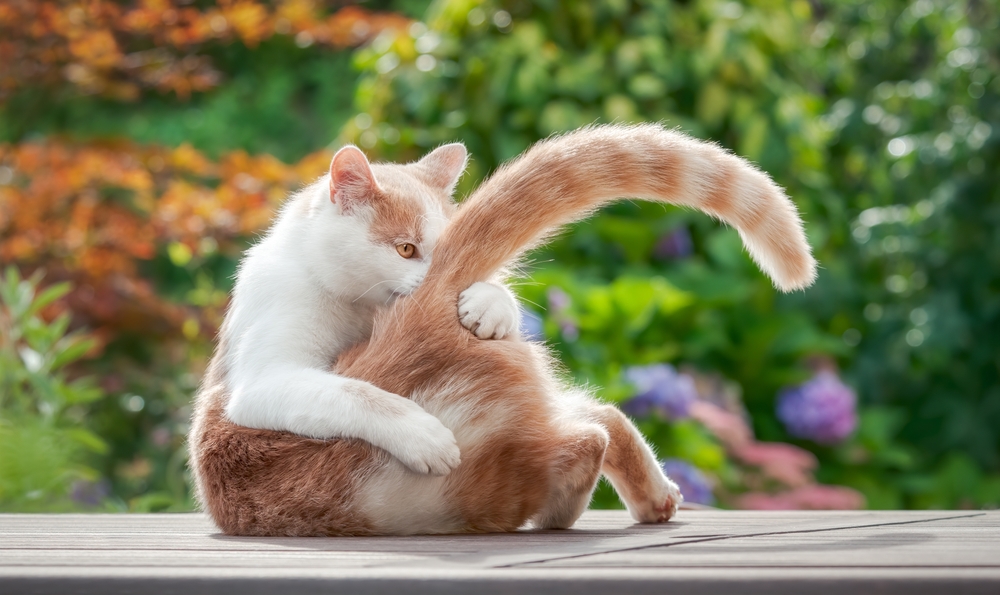
When you catch your cat in the act of chasing its tail, it’s akin to witnessing a playful feline game. This behavior is particularly common in kittens, serving as a whimsical exercise in honing their hunting skills. Tail-chasing is an indicator of joy and energy, a delightful display of their lively nature. However, if this playful pursuit becomes a frequent or distressed activity, there might be underlying reasons to consider.
Sometimes, tail-chasing hints at boredom or stress in cats. The lack of engaging activities or environmental stimulation may prompt this behavior. Addressing this concern involves introducing new toys, interactive play sessions, and creating an environment that keeps your cat entertained.
Additionally, tail-chasing can be a response to discomfort. Itchy skin caused by fleas or allergies may lead cats to chase their tails in an attempt to alleviate irritation. Observing the context and frequency of this behavior can provide insights into your cat’s well-being.
How to React When Your Cat Chases Its Tail?
If your cat’s tail-chasing looks like a happy game, that’s cool! They’re just having fun. You can let them enjoy it and maybe even play along. But if your cat seems stressed, angry, or chases its tail a lot, it’s time to help them out.
Give your cat more interesting things to do, like new toys or playtime together. This can help if boredom or stress is making them chase their tail too much. Always keep a positive attitude—cats can pick up on how you feel. If the tail-chasing keeps going, it’s a good idea to chat with a vet. They can check if there’s something bothering your cat, like an itch or other health stuff. That way, you and your cat can go back to enjoying happy, stress-free moments together!
Why Is My Cat Attacking His Own Tail?
When your cat takes a sudden interest in attacking its own tail, there are a few potential reasons behind this intriguing behavior. In many cases, it could be a playful expression, with your cat viewing its tail as a moving target to pounce on.
However, if this behavior becomes aggressive or frequent, it might indicate boredom, stress, or even an underlying health issue. Observing the context and any accompanying signs can provide clues to why your cat has turned its tail into a temporary adversary.
Do Cats Control Their Tails?
Cats do have some control over their tails, but it’s not as precise as their control over other body parts. The tail serves various functions, from aiding in balance to expressing emotions. While cats can voluntarily move their tails to a certain extent, many of the movements are instinctive reactions. Understanding the nuances of how cats interact with their tails offers insights into their communication and emotional states.
Final Thoughts about Why do cats chase their tails?
The playful dance of a cat chasing its tail holds a charming mystery. It’s a mix of instinctual joy and kittenish enthusiasm. Understanding these feline frolics reveals a range of reasons, from harmless play to potential health cues.
While the twirls may often be innocent, a watchful eye helps distinguish between carefree capers and signs of unease. As cat companions, recognizing these dynamics allows us to create a nurturing environment, swiftly address any concerns, and strengthen the delightful bond with our furry friends.

